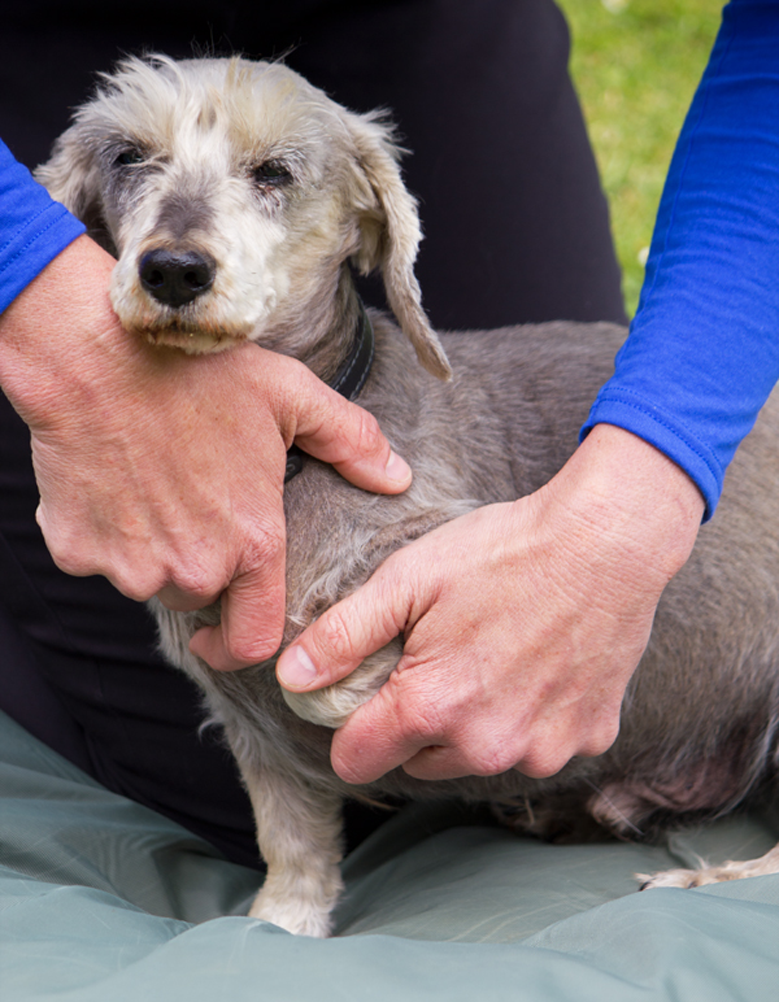Your initial visit consists of a lot of questions around your home environment and patterns, as well as your dog’s daily activities and habits. It is important to know all about beds, car types, sofas, flooring etc. as these may all have a bearing on your dog’s problem. There will then be an observation of the dog through gait cycles: walk, trot, canter (if possible), and we may ask to video this with your permission. If it is a working or agility dog, we may ask for video footage of the dog working, to show where there are difficulties.
There will be general palpation of your dog to find areas of tension or imbalance. From there; any neurological or orthopaedic examinations (which will be the same examinations as your Veterinary Surgeon may have already done).
If we feel it is suitable after these assessments, we will continue with a treatment. This may consist of soft tissue/massage type techniques, stretches, gentle manipulation, articulation, or cranial, balanced ligamentous techniques (gentle techniques).
Dogs generally enjoy treatment, though if we are working over a painful area, we work sensitively. In subsequent treatments, exercises or post treatment advice, such as hot or cold compresses may be given, or minor home adjustments may be suggested where necessary.
Your dog may experience some minor discomfort post treatment in some cases, which may manifest as a change in behaviour or short term increase in pain or stiffness. This should alleviate in 24-48 hours. Therefore, the recommendation for a working/racing dog is that they are not worked for this time scale.
During treatment your dog will not be muzzled, unless there is a history of biting, or if the owner has concerns. You will be asked to hold your animal in a safe way during treatment.
Osteopaths always work in conjunction with the dog’s veterinary surgeon and must, by law, obtain consent from the Vet for treatment of your dog.
If you are unsure as to the suitability of Osteopathy for your dog, please feel free to ask any questions via email or phone.
Dependent on whether this is an acute or chronic problem, number of treatments can vary from 2 to 3 for a straightforward muscle strain, to having regular treatments once a month e.g. for a dog with an arthritic condition, or for an agility or racing dog, to improve its performance.
Initial consultation including treatment 1 hour - £60
Returning appointment 30 mins - £47
For outside of 5 mile radius of Hurstpierpoint or Partridge Green, mileage is chargeable.
All Osteopaths are registered under the General Osteopathic Council by law. Anyone working with animals has to obtain additional insurance as well as consent from the relevant Veterinary surgeon to comply with law. Please feel free to ask for details of my insurance and registration upon request.
Most pet insurances are happy to cover Osteopathic treatment with an insured Osteopath, if the Vet recommends treatment and refers to the Osteopath, but please check with your insurers first.

Osteopathy can be helpful in cases of musculo-skeletal trauma, such as car accidents or home accidents. It works to aid lymphatic drainage and improve blood supply to promote healing. Trauma can also occur as a result of dogs fighting or playing too hard. Home accidents can occur through slipping on hard floors, repetitive ball or frisbee throwing, constantly getting on/off furniture or out of high cars. This may present as lameness, crying out when moving, or when touched in an area. Or you may notice a change in behaviour or temperament.
When a dog is older or if they are terminally ill, they may be regularly seeing the vet for injections or be on daily medication. Osteopathy can be a good adjunct to allopathic treatment in helping the dog feel more comfortable and to maximise their mobility. This may extend the symptom free period between injections and enhance the quality of life. Osteopathy is individual to each case and can be adapted to gentler techniques which are perfectly suitable to use on an elderly dog or in the case of palliative/end of life care.
Whether you have a racing, agility or working dog; a lot of the activities involve repetition and therefore muscular imbalances can occur. This may present as difficulty when encountering obstacles or a reluctance to jump, or reduced performance. Injuries can often occur as a result of landing awkwardly or collision with another dog.
Having osteopathic treatment can help balance your dog, prevent pain and improve performance.
Certain breeds have a genetic disposition to conditions; such as Labrador retrievers with hip dysplasia, dachshunds and basset hounds with disc prolapse. Osteopathic care in conjunction with veterinary intervention can often help to alleviate stiffness, pain and address muscular imbalances, and reduce spinal imobility occurring as a result of these pathologies.
Osteopathy can be useful to aid recovery post operatively by addressing spinal restrictions and muscular imbalances, helping to improve proprioception, core stability and joint mobility. This will be done in conjunction with vet post-operative recommendations, and would be a combination of hands on techniques and prescribed exercises.
If you have a large breed, strong willed dog, or an elderly dog that you are lifting, and are suffering with pain and/or stiffness yourself, then why not use Osteopathy to help correct these imbalances in conjunction with your dog having treatment. Nicky’s human practice is in Hurstpierpoint High Street and is able to discuss any aspects of osteopathic treatment with you via her website. www.sussex-osteopath.co.uk